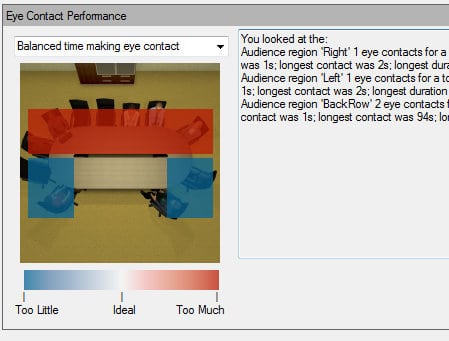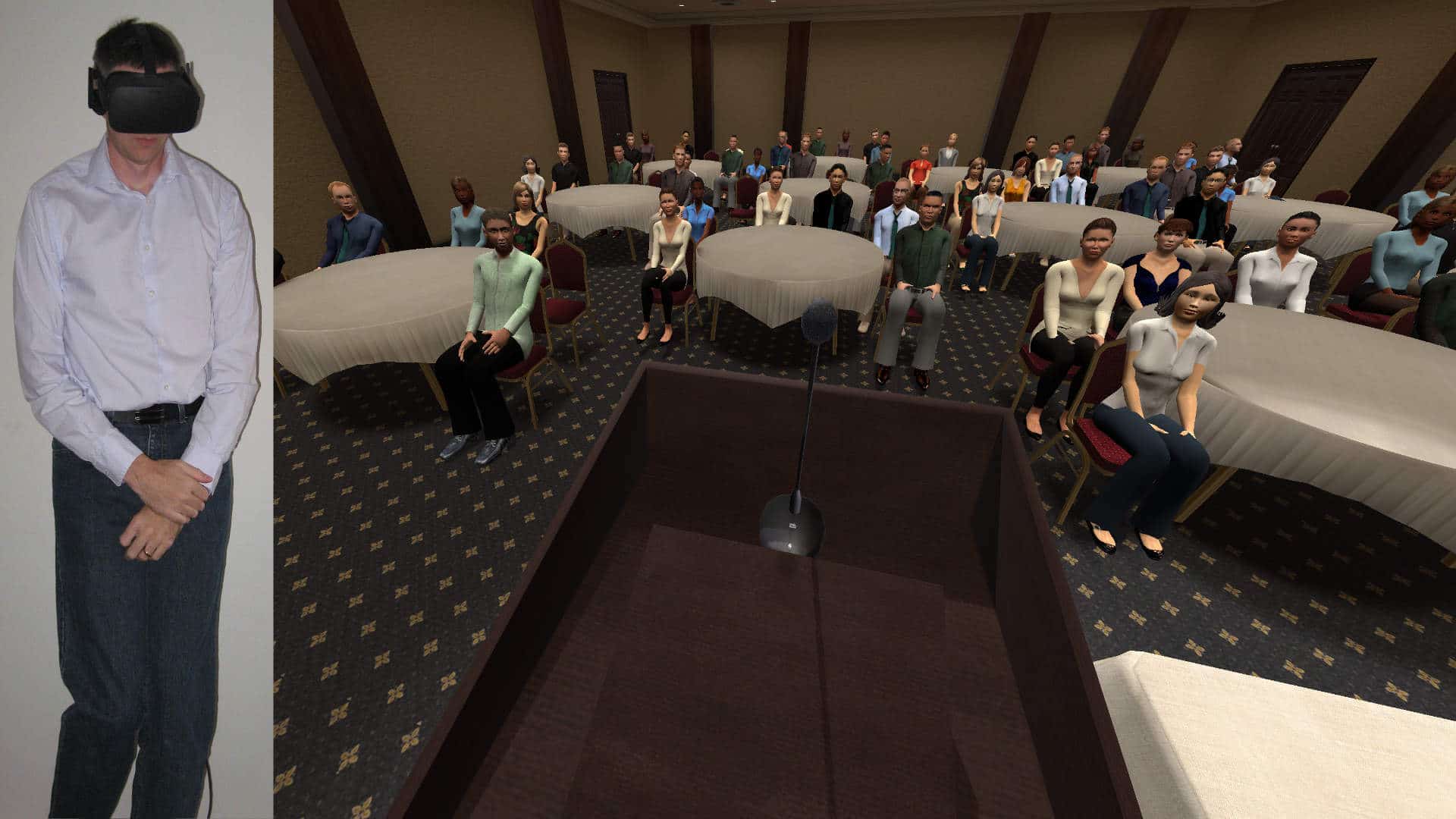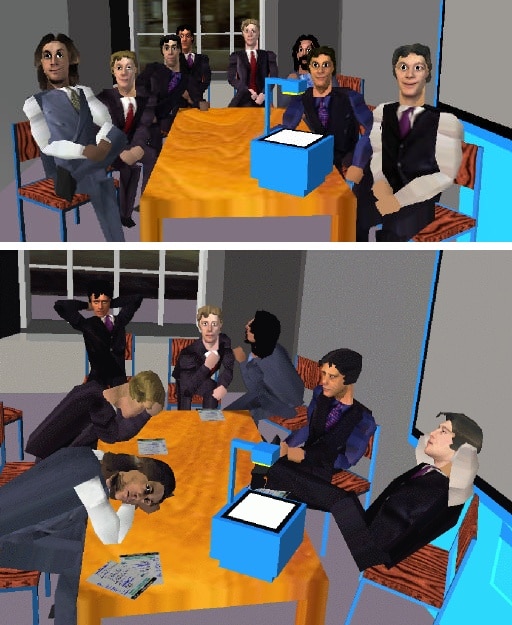Your cart is currently empty!
Skeptical of Virtual Reality being effective for Public Speaking? Wondering how real is the experience of being in front of people? Can it really be effective? for overcoming fear? for training skills or preparation of a presentation?
In this post I want to address those lines of questions. I understand your skepticism. Rather than just trying to assure you from my experience (even in the earlier, cruder days of VR, it was amazing effective), I highlight research that shows just that. I have tried to suppress the academic in me.
Is the experience really real?
For virtual reality to be effective, it needs to become your complete experience. This is why the research community often refers to immersive VR, to indicate it isn’t just a desktop game. So when you immerse yourself in the virtual world, you enter that reality. This is why HMDs (aka. VR goggles) are so powerful, it completely encompasses your vision.
If you haven’t experienced immersive Virtual Reality yet, it is hard to grasp how real the experience can be. I would highly suggest you find a PC based HMD, e.g. HTC Vive or Oculus Rift, and experience it for yourself. You are just going to have to believe me that the VR experience can be very real.
Reactions to Public Speaking in VR
Can a virtual public speaking experience really be real? Yes, and there is scientific evidence. One of the earliest scientific articles looking at peoples responses to VR was actually with public speaking. An image from that research can be seen to the right.
Prof. Slater’s group showed, in the early 2000s, that people not only reported being stressed by speaking to a small group of people in VR, but they had physiological stress responses. Look a moment at what they saw in the image to the right. People got stressed speaking in front of those avatars! If that works, imagine how effective the improved graphics and technology that have even at home today, like the Rift or Vive, can be!
Research over the years since with various systems shows people react in front of virtual audiences as they do in reality. They get stressed, like they do in reality. Heart rates increase, people sweat. People report stress. Various research studies show that responses are similar between real and virtual audience exposures.
Public Speaking in VR as a Psychology Research Tool
Right now, across the globe, Psychology research is being conducted using virtual audiences. This isn’t VR research or evaluating whether is good enough; it is using virtual audiences as a tool for understanding people better. Virtual audiences replace real audiences in the research, because the experience is real. Researchers are using virtual audiences to understand social components of autism. They are researching aspects of the fear of public speaking and testing new methods for helping people deal with their fears, all using virtual audiences.
When we take all of this together, we see strong evidence that the experiences when presenting virtual audiences are very real and comparable to real life. We find more support for the effectiveness of VR public speaking in two specific cases: clinical treatment of glossophobia or the fear of public speaking and training skills with applications like Virtual Orator.
Fear of Public Speaking – VR Therapy
One of the areas, where VR has been successful since well before the recent commercial revolution is something called Virtual Reality Exposure Therapy (VRET). VRET is using VR in clinical Psychology. It is a VR adaption of one of the main ways Psychologist help people deal with their fears, something called Exposure Therapy. Basically it is learning to deal with your fear by confronting it in a controlled manner. (see this post for more)
In general, research has shown over many years that these VR-based therapies are effective. Two of the most common VRET applications are fear of heights and fear of spiders. Research generally shows VRETs to be at least as effective as exposing patients to the real counter part. Some research even indicates it is better! (see Opris et al. 2011 for a review)
Research with fear of public speaking has shown it to be effective for helping deal with the fear. For example, Wallach and colleagues compared traditional real world therapy with VR based therapy and found similar results, even a year after treatment. Plus, a higher percent of patients completed the VR therapy.
Training Skills in VR
Public speaking isn’t just about fear, though if you are like the majority of people it might not seem like that when you present. Public speaking is a craft, made up of lots of skills. The type of skills required for public speaking are ideal for training in VR.
VR training hasn’t gotten a lot of press recently, but VR based training has been around for a while and is growing quickly. It has been used in medical training for more than a decade, for instance training laproscopic procedures. Your future doctors are likely training in VR today. The military has been using VR for decades. Military flight simulators were the ultimate VR for many years. Now days, the military trains many different scenarios in VR, e.g. handling of stressful intra-personal situations and combat situations like clearing a house.
The critical question is: do skills that you learn/train in VR transfer to the real situation. The experts call this skill transfer. There are plenty of studies showing transfer of skills from virtual to real situations in various fields. VR training is particular good with learned procedures, such as our tip for making eye contact with the whole room.
Social skills have also been shown to transfer, such as recent studies by Smith et al. They showed improvements in interview skills for veterans with PTSD and others when they received VR training. There is also a large recent trend of research on helping autistic children develop social skills with the help of VR simulations.

Virtual Audiences; Real Speaking Experiences
Virtual audiences in a virtual world all generated by a computer. The graphics might not be realistic, but the experience of presenting to those people is. In this post I’ve provide a bit of an overview of the research that shows that VR experiences are quite real. Speaking to a virtual audience causes stress reactions, like happen in front of a real audience.
We’ve heard how both clinical and research Psychologists are using VR public speaking applications. They’re helping people get over their fears. Their learning how better to help you, by understanding the mechanisms that cause it and training methods that help alleviate fear. We’ve covered how training in VR can lead to real life success.
Dr. Blom is a long time researcher in the VR field. He is the founder of Virtual Human Technologies, which applies VR and avatar technologies to human problems and helping better understand people. Virtual Orator exists largely because Dr. Blom wishes he had had such a tool instead of the ‘trail by fire’ he went through learning to speak in public.




Leave a Reply